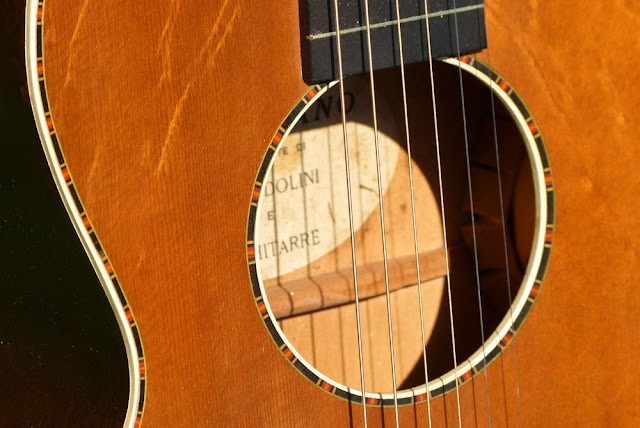1920s Harmony-made Galiano Parlor Guitar
This is one of many guitars I've been working on for a long-time customer of mine (we're not sure if it's available for sale, yet), and while it's got a giant old Galiano label in the soundhole that might suggest it's an Oscar Schmidt-made box, it's actually a late-20s Harmony product and very, very typical of their work from the time, except for the very cool bearclaw figure on the face.
Although this came to me with a replacement rosewood bridge, it needed the usual work that Harmony instruments from the time tend to need -- a neck reset, fret level/dress, seam repairs, brace reglues, and a new nut and saddle. It's now playing spot-on with 1/16" DGBE and 3/32" EA action at the 12th fret, though the super-lightweight build requires stringing these with very light strings. I'm using a typical extra light 46w-10 set on here right now and that's the heaviest I'd suggest for standard tuning. I know these guitars quite well -- they were my bread and butter fixer-uppers years ago -- and they're built just a tiny bit heavier than your average classical, though they're ladder-braced.
Of course, add that light build and light stringing into the mix with a short 24 1/8" scale length, medium-sized V-shape neck, 12-fret joint, and big 1 13/16" nut, and you have something that makes a great "couch potato" fingerpicker's guitar.
The amazing bit about this instrument is that it has zero cracks. That's a pretty hard thing to find for something pushing 85-90 years or so (as of this post).
The top is solid spruce and the back and sides are brown-stained solid birch. It has a poplar neck, dyed-maple fretboard (with some cool ray-fleck), and a replacement (60s?) rosewood bridge.
My new bone nut is an improvement over the bit of mealy wood that I knocked off.
These brass-plate tuners are the originals and work just fine.
The dyed-maple fretboard has a flat profile and celluloid dots inlaid. It also has the original, tiny, brass frets. Hilariously, though these frets never feel as slick as any modern wire, my level/dress job changed them from almost square in shape (as per the original specs which I've seen over and over) to something that you won't zip and snag your fingers on near as much.
I also added side-dots to match the face dots.
I also added side-dots to match the face dots.
The binding near the neck block on the bass side is a little chipped-out (there's also one spot on the lower bout where it is, too) and there's some chipping-out on the fretboard at the joint, too. The fretboards on these tend to get quite fragile with age and there's one smallish hairline crack at the fretboard extension, too, right in the board (stable).
After the neck reset, I simply glued the fretboard extension back down onto the top, and thus it dips a bit down towards the body after the 12th fret. Fortunately -- your average player isn't going to go groping around up there, anyhow.
After the neck reset, I simply glued the fretboard extension back down onto the top, and thus it dips a bit down towards the body after the 12th fret. Fortunately -- your average player isn't going to go groping around up there, anyhow.
Check out all that nice, tight-grain spruce with the bearclaw figure in it! Then note how nice it looks matched with the brown/orange/blue/green purfling borrowed fro the Chicago furniture industry.
This replacement bridge was installed nicely. I did need to expand and slightly re-orient the saddle slot, however, and make a new saddle after the neck reset. I also lightly string-ramped behind the saddle and fit the (replacement, old) pins a little better. Note two tiny filled holes near the pins -- probably from someone using bolts to glue it to the top a long time ago.
Gotta love that figure!
The back and sides are the oft-seen brown-stained birch found on any number of Harmony, Regal, and Kay products of the 20s/30s/40s. The back has a decal "backstrip."
This guitar is just-under a 12-fret 0-size instrument at 13" on the lower bout but sporting a shorter, overall, body. This puts it in the modern "parlor" category. If you've ever held one of those Art & Luthierie "Ami" guitars, this is about that size.
The only seam creep is right here at the endpin, and tiny. It's all glued-up and stable, too. Note the replacement, ebony, pin.





















Comments
Also, while not obvious to most folks, these have a peculiar body shape that also easily marks them out from a Regal or Kay which use a less round/pinched shape at the waist.